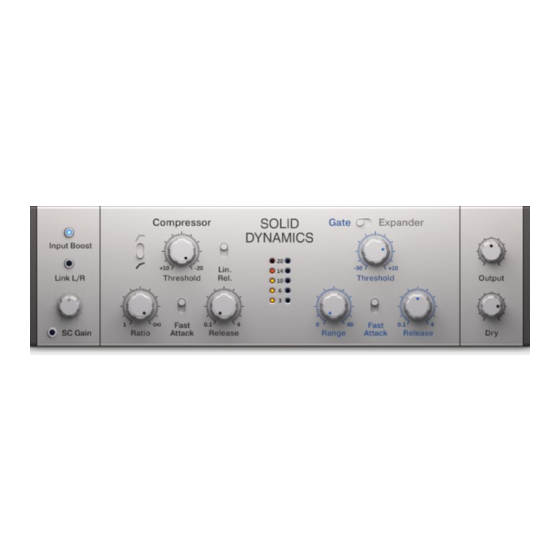
Advertisement
Quick Links
Advertisement

Subscribe to Our Youtube Channel
Summary of Contents for NI SOLID MIX Series
- Page 1 Manual...
- Page 2 Native Instruments GmbH, hereinafter referred to as Native Instruments. “Native Instruments”, “NI” and associated logos are (registered) trademarks of Native Instru- ments GmbH. Mac, Mac OS, GarageBand, Logic, iTunes and iPod are registered trademarks of Apple Inc., registered in the U.S.
- Page 3 Contact Germany Native Instruments GmbH Schlesische Str. 29-30 D-10997 Berlin Germany www.native-instruments.de Native Instruments North America, Inc. 6725 Sunset Boulevard 5th Floor Los Angeles, CA 90028 www.native-instruments.com © Native Instruments GmbH, 2012. All rights reserved.
-
Page 4: Table Of Contents
Table of Contents Table of Contents Welcome to SOLID DYNAMICS ..................5 What Is a Compressor? ....................... 5 What Is an Expander/Gate? ......................6 Common Parameters and Features ..................... 8 The SOLID DYNAMICS ........................9 Using the SOLID DYNAMICS ..................10 The Menu Bar .......................... -
Page 5: Welcome To Solid Dynamics
Welcome to SOLID DYNAMICS What Is a Compressor? Welcome to SOLID DYNAMICS SOLID DYNAMICS brings the compressor/expander/gate section of one of the most renowned studio mixing consoles of all times into your studio by way of FX Framework. What Is a Compressor? Technically speaking, a compressor is an audio processing unit that reduces the dynamic range of an incoming signal, i.e. -
Page 6: What Is An Expander/Gate
Welcome to SOLID DYNAMICS What Is an Expander/Gate? Using compression is a fine art: You can easily destroy your sound if you don’t carefully set the compression parameters! For each purpose, specific settings are required. A good understand- ing of each parameter’s effect, together with experience gained by using the compressor, will allow you to achieve great results! In addition to the above listed common applications there is room for your own experiments, so feel free to use your compressor in a way not listed here. - Page 7 Welcome to SOLID DYNAMICS What Is an Expander/Gate? ▪ Eliminate unwanted background noise, such as headphones bleed when recording vocals, amplifier hum when recording a guitar or bass, etc. ▪ Control bleed levels across multiple microphones in a complex recording (e.g. on a drum- set).
-
Page 8: Common Parameters And Features
Welcome to SOLID DYNAMICS Common Parameters and Features Common Parameters and Features The compression/gating/expanding process can be further tuned by using additional parame- ters and features. Attack and Release The attack time can define how long it takes for the compressor to come into full effect (or for the gate/expander to recover from attenuating the input) when the threshold level is reached. -
Page 9: The Solid Dynamics
Welcome to SOLID DYNAMICS The SOLID DYNAMICS Parallel Processing Sometimes you may want to keep the original signal and blend it with the compressed/gated/ expanded signal. Setting up a signal path for parallel compression/gating/expanding can help re- tain some of the sonic characteristics of your original instrument (mainly the transients), for example when a signal is heavily compressed and in need of some top-end sparkle. -
Page 10: Using The Solid Dynamics
Using the SOLID DYNAMICS The Menu Bar Using the SOLID DYNAMICS This chapter describes how to use the SOLID DYNAMICS. The Menu Bar At the very top of the SOLID DYNAMICS interface, you will see the Menu bar. This is primarily used for saving and loading presets, but also has a few other functions. - Page 11 Using the SOLID DYNAMICS The Menu Bar If you wish to remove a preset you no longer want, you can delete it by selecting Delete from the File menu. Please note: you are not able to delete factory content. Loading Presets In the center part of the Menu bar, you will see the Preset menu.
-
Page 12: The Main Interface
Using the SOLID DYNAMICS The Main Interface You will now be editing and listening to the parameters of slot B, until you click the → switch again. To copy the settings of slot A to slot B: Go to the File menu on the left side of the Menu bar and select Copy A to B from the list. ►... - Page 13 Using the SOLID DYNAMICS The Main Interface The SOLID DYNAMICS user interface. SC Gain button: Enables/disables the side-chain input. The side-chain circuitry allows you to feed the compressor’s detector with another control signal instead of the input signal itself (see ↑1.3, Common Parameters and Features for more info on this).
- Page 14 Using the SOLID DYNAMICS The Main Interface With this switch set to its bottom setting “soft,” the transition is smoother: The compression actually starts somewhere below the threshold and progressively raises until it reaches the pre- defined ratio somewhere above the threshold. Notably, this setting might sound better on vo- cals.
- Page 15 Using the SOLID DYNAMICS The Main Interface (14) Range knob: Adjusts the range (maximum attenuation) of the gate/expander. This directly affects how much gain reduction is applied to the input signal. The range is measured in deci- bels. At full left (0), no gating/expanding is applied and the signal is left untouched. The more you turn this knob clockwise, the more the gain of the input signal is attenuated when it falls under the threshold level.
Need help?
Do you have a question about the SOLID MIX Series and is the answer not in the manual?
Questions and answers